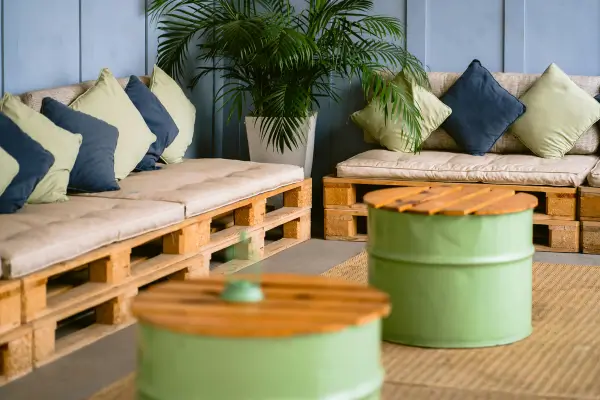Creating a vertical garden with recycled materials is an eco-friendly way to add greenery to small spaces. It’s perfect for transforming unused items into functional, beautiful plant displays.
From plastic bottles to wooden pallets, recycled materials make gardening sustainable and stylish. With simple steps, you can build a compact garden that fits any environment.
Start today and bring life to your space with a creative vertical garden. Let’s explore how to design one step by step.
Turn waste into wonder and enjoy the beauty of nature!
Why a Vertical Garden?
Before diving into the process, let’s explore why vertical gardens are such a fantastic idea:
- Space-Saving: Perfect for small balconies, patios, or even indoor spaces.
- Eco-Friendly: Reuses materials that would otherwise go to waste.
- Versatile: Suitable for growing herbs, flowers, vegetables, or decorative plants.
- Aesthetic Appeal: Adds a touch of greenery and liveliness to any environment.
Materials You’ll Need
To create a vertical garden using recycled materials, gather the following items:
- Recycled Containers: Plastic bottles, tin cans, wooden pallets, or old shoe organizers.
- Soil: Choose potting soil suitable for the plants you want to grow.
- Plants or Seeds: Herbs, succulents, flowering plants, or vegetables.
- Tools: Scissors, a utility knife, a drill, and screws (if needed).
- Hanging Materials: Rope, hooks, or nails to secure the garden to a wall or structure.
- Optional Extras: Paint or decorative materials to personalize your garden.
Step-by-Step Instructions
1. Choose Your Location
Selecting the right spot for your vertical garden is crucial. Consider:
- Light Requirements: Ensure the area receives enough sunlight for the plants you intend to grow.
- Accessibility: The garden should be easy to reach for watering and maintenance.
- Protection: Avoid areas exposed to strong winds or harsh weather conditions.
If you’re growing indoors, opt for spots near windows or use grow lights to mimic natural sunlight.
2. Select Your Recycled Materials
The beauty of a vertical garden lies in its flexibility. Here are some creative options for recycled materials:
- Plastic Bottles: Cut them in half and use the bottom part as planters. Hang them with rope or attach them to a wooden frame.
- Tin Cans: Drill small drainage holes at the bottom and paint them for a colorful display.
- Wooden Pallets: Attach planters or pockets to the slats for a rustic and organized design.
- Old Shoe Organizers: Perfect for small plants like herbs or succulents. Hang it on a wall or door.
Pro Tip:
Ensure all materials are clean and safe for planting, especially those that previously held non-food items.
3. Prepare the Containers
Once you’ve chosen your materials, it’s time to prepare them:
- Clean Thoroughly: Wash all containers with soap and water to remove dirt and residues.
- Add Drainage: Drill small holes at the bottom of each container to prevent waterlogging.
- Customize the Look: Paint or decorate the containers to match your space’s aesthetic.
4. Assemble the Structure
Your vertical garden needs a sturdy base or frame. Here’s how to set it up:
- Wall-Mounted Garden: Attach containers directly to a wall using hooks or screws.
- Freestanding Garden: Use a wooden pallet or build a frame from scrap wood for a portable solution.
- Hanging Garden: Suspend containers with ropes, creating layers for a cascading effect.
Make sure the structure is stable enough to support the weight of the plants and soil.
5. Add Soil and Plants
- Fill Containers with Soil: Use high-quality potting soil suitable for your chosen plants.
- Plant Carefully: Place seeds or seedlings in the soil, ensuring enough space for roots to grow.
- Water Gently: Water the plants immediately after planting to help them settle.
6. Watering and Maintenance
Vertical gardens require regular care to thrive. Follow these tips:
- Watering: Check the soil moisture daily and water as needed. Be careful not to overwater, especially for succulents.
- Pruning: Trim plants regularly to prevent overcrowding and encourage healthy growth.
- Fertilizing: Use organic fertilizers to boost plant health without harming the environment.
- Pest Control: Inspect plants for pests and use natural remedies like neem oil if needed.
Creative Ideas for Your Vertical Garden
Here are some unique ways to personalize your vertical garden:
- Herb Wall: Grow culinary herbs like basil, mint, and parsley for easy access in the kitchen.
- Succulent Art: Arrange succulents in patterns to create a living wall display.
- Edible Garden: Grow small vegetables like cherry tomatoes, lettuce, or peppers.
- Flower Showcase: Use vibrant flowering plants to add color and charm.
- Themed Garden: Create sections based on plant types, like an all-succulent or all-edible garden.
Benefits of Recycled Vertical Gardens
- Environmentally Friendly: Reusing materials reduces waste and promotes sustainability.
- Cost-Effective: Most recycled items are readily available and free.
- Educational: A great project for teaching kids about gardening and recycling.
- Improves Air Quality: Plants help purify the air, making your space healthier and more refreshing.
Common Mistakes to Avoid
- Overwatering: Too much water can lead to root rot. Ensure proper drainage.
- Overcrowding: Leave enough space between plants for healthy growth.
- Wrong Materials: Avoid containers made of toxic materials that may leach into the soil.
- Inadequate Sunlight: Place the garden in a spot with sufficient light for the plants’ needs.
Conclusion
Creating a vertical garden with recycled materials is a rewarding project that combines creativity, sustainability, and functionality. By repurposing everyday items, you can build a beautiful and eco-friendly garden that enhances your living space. Whether you’re growing herbs, flowers, or vegetables, this guide equips you with everything you need to get started. So grab those recycled containers, gather your plants, and let your vertical garden bloom!



